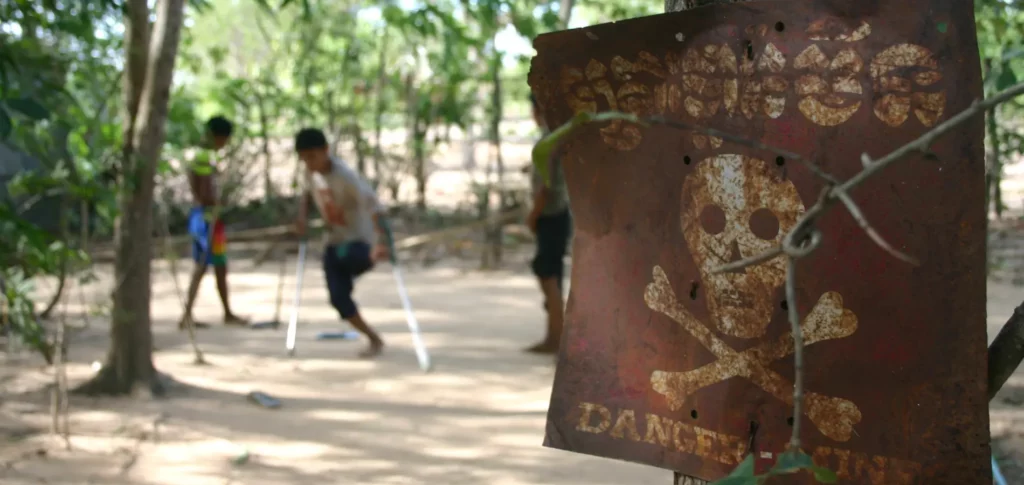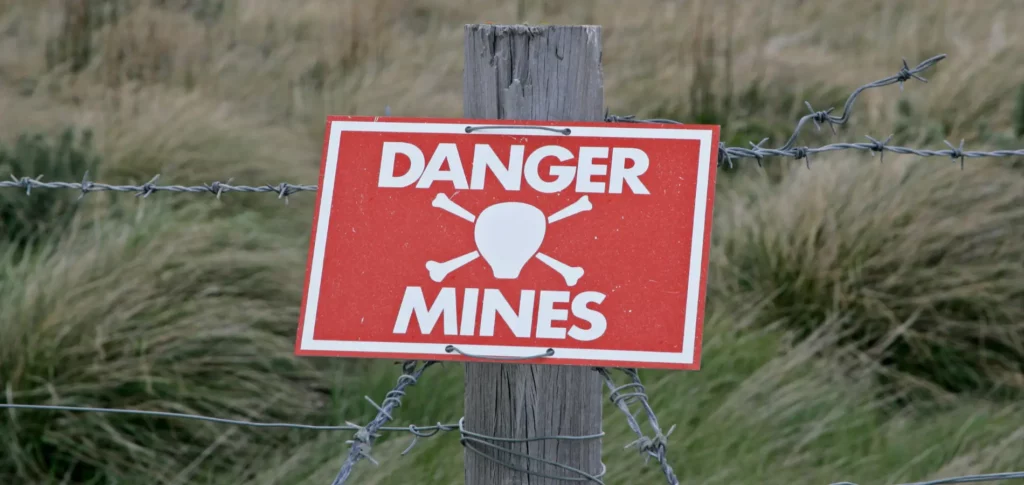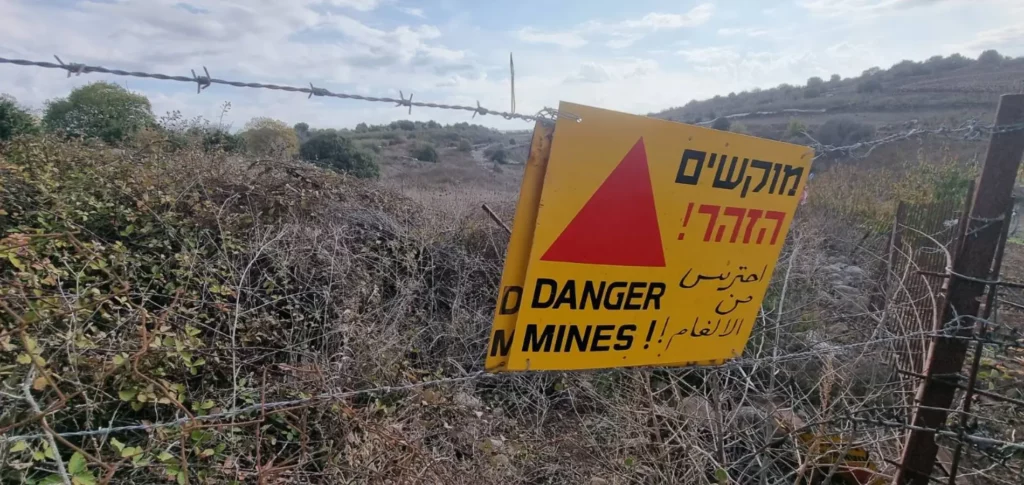Brimstone Marks International Mine Awareness Day 2024
International Mine Awareness Day is celebrated around the world on 4th April. This is an incredibly important day because even when conflicts end and peace agreements are reached, landmines and explosive remnants of war (ERW) can persist for decades, posing a deadly threat to millions of people around the world.
Despite the introduction of the landmine ban in 1997, to this day, landmines are still used in countries around the world, leading to thousands of injuries and fatalities each year.
To mark this year’s International Mine Awareness Day, Brimstone is taking an in-depth look at landmine use in recent years, its devastating impact and why landmine action cannot wait.
What are landmines?
There are multiple types of landmines used around the world, and these can be split into two main categories:
- Anti-personnel mines: designed to explode from the presence, contact or proximity of a person.
- Anti-vehicle mines: designed to explode from the presence, contact or proximity of a vehicle.
Landmines are placed on or under the ground and can remain dormant for decades until a person, animal or vehicle triggers them. They therefore pose a significant risk to civilian safety not only during conflicts but for many years after.
As landmines are victim-activated, they are incapable of distinguishing between the presence of a soldier, an aid worker, peacekeepers, civilians, or a child. They cannot be aimed, and indiscriminately kill or injure.

The history of landmines
There isn’t a definitive answer for when landmines were first invented. The United Nations Mine Action Service (UNMAS) reports that modern landmines can be traced back to the American Civil War, which took place from 1861 to 1865. Later, they were used in WWI to defend against enemy tanks.
The first large-scale use of the devices is believed to be in WWII when anti-personnel mines were developed to restrict the movement of opposition forces and protect anti-tank mines and strategic areas.
Over time, landmines have become more advanced and deployed on a wider scale, being used in countless conflicts around the world. From the S-mine (also known as the Bouncing Betty) and air-delivered mines to Claymore mines and the recent invention of Smart Mines, they have grown more sophisticated, and more deadly.
The impact of landmines
As we’ve mentioned previously, landmines pose a serious and constant threat to civilians around the world. They also have widespread social, economic, and environmental impacts on the areas they contaminate.
As anti-personnel mines are indiscriminate and stay in or on the ground long after conflicts have ended, the majority of victims are civilians. This is reflected in the data shared by the Landmine Monitor Report, which stated in 2022, civilians made up 85% of all casualties recorded where the civilian, deminer or military status of the casualty was known.
Landmine contamination isn’t limited to the enemy frontlines. These devices can be found on farmland, on roads and footpaths, along borders, near homes and schools, and in many other urban and rural areas where communities are trying to carry out their daily lives.
Mines can deny access to food, water, and other basic needs, restricting the free movement of communities and instilling constant fear in individuals. In areas with landmine contamination, individuals are often aware that they are walking in dangerous areas, but they have no option but to do so. There is no other farmland they can use, another route to water or a way for children to get to school.
Landmines can also have a devastating impact on the movement of refugees, and hinder their return, along with hampering the delivery of vital humanitarian aid.
As mentioned previously, landmines are incredibly deadly, injuring and killing people every day. Many people are killed on the spot due to blood loss, shock, or damage to vital organs. Common injuries from landmines include severe foot and leg injuries, along with infections, all of which often result in amputation.
Children who are injured by landmines can often struggle with the impacts for the rest of their lives. They might never be able to return to school, struggle with the financial cost of prosthetic limbs (which will need replacing regularly until they’re an adult), and they may even face social exclusion.
Landmines are also an obstacle to economic growth. They place limitations on land which could be used for farming, water access, roads, and vital infrastructure.
These are just a few examples of the devastating impacts of landmines.

The Mine Ban Treaty
Before the 1990s, anti-personnel mines had been used around the world in one form or another by most armed forces. The impacts of such widespread use were devastating, prompting the founding member organisations of the International Campaign to Ban Landmines (ICBL) to join forces in 1992 to address the problem.
Anti-personnel mines violate international humanitarian law due to the fact they are indiscriminate and inhumane weapons. The law of war imposes restrictions on how combatants operate, stating that they must distinguish between civilian and military targets and that the injuries inflicted should be proportionate to military objectives. Anti-personnel mines fail both the discrimination and the proportionality tests. Due to this reason and the fact their threat can potentially remain for decades after they’re placed, it was determined that the only way to address the crisis was a complete, worldwide ban.
The ICBL, International Committee of the Red Cross (ICRC) and United Nations (UN) put in motion what went on to be known as the “Ottawa Process”, which eventually led to the adoption of the Mine Ban Treaty in September 1997. The ban was adopted in Oslo, Norway, before being opened for signatures on 3rd December 1997 in Ottawa, Canada. It entered into force on 1st March 1999.
The Mine Ban Treaty, sometimes known as the Ottawa Treaty, is officially known as ‘the Convention on the Prohibition of the Use, Stockpiling, Production and Transfer of Anti-Personnel Mines and on their Destruction’ and is a comprehensive ban on all anti-personnel mines. Governments that sign the treaty must:
- Stop the use, stockpiling, production, and transfer of anti-personnel mines immediately.
- They must destroy all stockpiled anti-personnel mines within four years.
- They must clear all anti-personnel mines in areas under their jurisdiction within 10 years.
- In mine affected countries, mine risk education must be conducted to help prevent incidents, and until mines can be cleared, civilians must be excluded from contaminated areas.
- Assistance must be provided for the care and treatment of landmine survivors, their families, and communities. This includes rehabilitation and social and economic reintegration.
To this day, 164 State Parties have joined the treaty. 32 State Parties have not yet joined. The last countries to join the treaty were Palestine and Sri Lanka in 2017.
Afghanistan, Albania, Algeria, Andorra, Angola, Antigua and Barbuda, Argentina, Australia, Austria, Bahamas, Bangladesh, Barbados, Belarus, Belgium, Belize, Benin, Bhutan, Bolivia, Bosnia and Herzegovina, Botswana, Brazil, Brunei Darussalam, Bulgaria, Burkina Faso, Burundi, Cambodia, Cameroon, Canada, Cape Verde, Central African Republic, Chad, Chile, Colombia, Comoros, Congo, Cook Islands, Costa Rica, Cote d’Ivoire, Croatia, Cyprus, Czech Republic, Democratic Republic of Congo, Denmark, Djibouti, Dominica, Dominican Republic, Ecuador, El Salvador, Equatorial Guinea, Eritrea, Estonia, Eswatini, Ethiopia, Fiji, Finland, France, Gabon, Gambia, Germany, Ghana, Greece, Grenada, Guatemala, Guinea, Guinea Bissau, Guyana, Haiti, Holy See, Honduras, Hungary, Iceland, Indonesia, Iraq, Ireland, Italy, Jamaica, Japan, Jordan, Kenya, Kiribati, Kuwait, Latvia, Lesotho, Liberia, Liechtenstein, Lithuania, Luxembourg, North Macedonia, Madagascar, Malawi, Malaysia, Maldives, Mali, Malta, Mauritania, Mauritius, Mexico, Moldova, Monaco, Montenegro, Mozambique, Namibia, Nauru, Netherlands, New Zealand, Nicaragua, Niger, Nigeria, Niue, Norway, Oman, Palau, Palestine, Panama, Papua New Guinea, Paraguay, Peru, Philippines, Poland, Portugal, Qatar, Romania, Rwanda, Saint Kitts and Nevis, Saint Lucia, Saint Vincent and the Grenadines, Samoa, San Marino, Sao Tome and Principe, Senegal, Serbia, Seychelles, Sierra Leone, Slovakia, Slovenia, Solomon Islands, Somalia, South Africa, South Sudan, Spain, Sri Lanka, Sudan, Suriname, Sweden, Switzerland, Tajikistan, Tanzania, Thailand, Timor-Leste, Togo, Trinidad and Tobago, Tunisia, Turkey, Turkmenistan, Tuvalu, Uganda, Ukraine, United Kingdom, Uruguay, Vanuatu, Venezuela, Yemen, Zambia, Zimbabwe.
Armenia, Azerbaijan, Bahrain, China, Cuba, Egypt, Georgia, India, Iran, Israel, Kazakhstan, North Korea, South Korea, Kyrgyzstan, Lao PDR, Lebanon, Libya, Micronesia, Mongolia, Morocco, Myanmar, Nepal, Pakistan, Russia, Saudi Arabia, Singapore, Syria, Tonga, United Arab Emirates, United States, Uzbekistan, Vietnam.
Thanks to the Mine Ban Treaty, there has been a significant drop in landmine use, manufacturing, trade, stockpiling and contamination around the world. This is due to the global stigma that has developed over the years. Large areas of land have been cleared of contamination, the rights and needs of landmine victims have become more well known, and the number of landmine victims has declined. However, despite the success of the treaty, many challenges remain.
Landmine use in recent years
The Landmine Monitor Report assesses the impact of landmine contamination around the world and covers landmine use and treaty progress. The 2023 report focuses on the calendar year 2022, with information included up to October 2023 where possible.
Landmine casualties
The report states that in 2022:
State not party Syria recorded the highest number of annual casualties in 2022 for the third consecutive year, with over 800 casualties. This was followed by State Party Ukraine, which recorded 608 casualties and saw a ten-fold increase in the number of civilian casualties compared to 2021.
The report found that at least 1,171 landmine casualties in 2022 were children, meaning almost 50% of civilian casualties and one-third of all casualties in 2022 (where the age group was recorded) were children. As in previous years, most child casualties were boys, who made up 79% of casualties where the gender was recorded.
Landmine usage and contamination
The Landmine Monitor Report states:
- Landmine and ERW contamination in Ukraine has escalated after Russia’s invasion in February 2022. 11 of Ukraine’s 27 regions have been contaminated, with reports that Russia has used at least 13 types of anti-personnel mines in Ukraine since February 2022. There are also reports that Ukrainian government forces have used anti-personnel landmines in violation of the Mine Ban Treaty in and around the city of Izium in 2022.
- New landmine use has been reported in Myanmar every year since the publication of the first annual report in 1999. 2022 was no exception, with reports of a significant increase in new mine use which could be linked to the military coup that took place on 1st February 2021.
- The National Liberation Army (ELN), dissident groups of the Revolutionary Armed Forces of Colombia-People’s Army (FARC-EP or FARC) and other NSAGs in Colombia continue to produce and use anti-personnel landmines. There was a 30% annual increase in incidents of reported mine use compared to 2021.
- There were several incidents of anti-personnel landmine use in India in 2022 and 2023 by the Communist Party of India-Maoist or its People’s Liberation Guerrilla Army.
- Anti-personnel landmines were used sporadically in 2022 and 2023 by Pattani rebel groups in southern Thailand.
- Victim-activated IEDs have reportedly been used by Islamist groups in Tunisia.
- The report also highlights improvised anti-personnel mine use in the Sahel.

Stockpile destruction
One of the requirements of the Mine Ban Treaty is for states to destroy their stockpiles of anti-personnel landmines. They must report on their progress of stockpile destruction, along with any plans for the use of retained mines.
Out of the 164 State Parties that have joined the Treaty, it is reported that 67 confirmed they never possessed anti-personnel mines, and 94 have officially completed the destruction of their stockpiles. This has resulted in over 55 million anti-personnel mines being destroyed!
There are 66 States Parties who have retained anti-personnel mines for research and training.
Landmine clearance
The Mine Ban Treaty states that once a State Party signs the treaty, they must complete the clearance of all areas contaminated with anti-personnel mines within 10 years. They may request an extension to their deadline in exceptional circumstances.
According to the Landmine Monitor report, a total of 219.31km² of contaminated land was cleared by State Parties in 2022.
Risk education and victim assistance
State Parties who sign the Mine Ban Treaty are also responsible for providing ongoing victim assistance. This can include medical care, physical rehabilitation, psychological support, and the enforcement of relevant laws or policies to name a few examples.
Out of the 33 State Parties with clearance obligations in 2022, 28 were reported to be providing risk education to those at risk from anti-personnel mines. This included those who travelled regularly between different locations, such as agricultural workers, shepherds, headers, nomads and refugees or internally displaced persons, and those who deliberately engaged with items of ordnance, such as scrap metal collectors.
Children are a key target group for risk education. The Landmine Monitor report states that in 2022, children made up 47% of all beneficiaries reached by landmine risk education.

International Mine Awareness Day
On 8th December 2005, the United Nations General Assembly declared that the 4th of April of each year shall be observed as the International Day for Mine Awareness and Assistance in Mine Action. The day aims to raise awareness of the deadly legacy of landmines and campaigns for a landmine free world.
In 2024, UNMAS is using International Mine Awareness Day to advocate for a greater awareness of the needs and rights of people with disabilities in conflict and peacebuilding settings. It is calling for Member States and Security Council Members to protect persons with disabilities, ensuring they have access to assistance and are included in conflict prevention and peacebuilding.
On International Mine Awareness Day, Brimstone continues to support the call to cease the use of landmines around the world. We also celebrate the incredible work of deminers who risk their lives every day to create a safer world.
Brimstone UXO
If you found this article interesting, we recommend you also take a look at some of our other blogs, including:
- Sea Mines: The Story of Underwater UXO
- What is Unexploded Ordnance (UXO)?
- Rising Temperatures, Rising Risks: UXO and the Climate Crisis
You can keep up to date with Brimstone by following us on Facebook, Instagram, X (formerly known as Twitter), LinkedIn and YouTube.